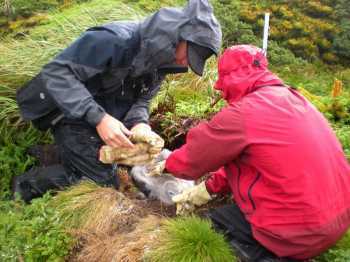The paper's abstract follows:
Southern Giant Petrels Macronectes giganteus of Gough Island show marked sexual dimorphism in bill measurements with no overlap in culmen. Recaptured incubating birds assigned as males showed considerable wear to their metal bands within seven years whereas bands worn by assigned females showed no discernible wear over the same time period. This is thought due to the more terrestrial foraging behaviour of males as against the more at-sea foraging behaviour of females. Eight birds colour-banded at Gough were seen at sea off Tristan da Cunha, c. 400 km away, while still breeding.
Reference:
Cooper, J. & Parker, G.C. 2011. Observations of sexual dimorphism among the Southern Giant Petrels Macronectes giganteus of Gough Island. Sea Swallow 60: 84-90.
Banding a Southern Giant Petrel chick on Gough Island
Photograph by Michelle Steenkamp
John Cooper, ACAP Information Officer, 18 September 2011, updated 12 December 2011

 English
English  Français
Français  Español
Español 